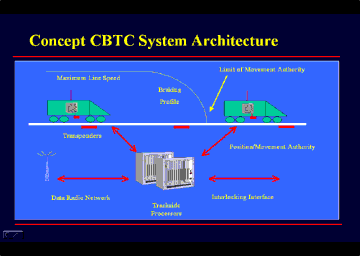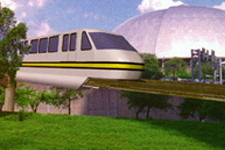Rail Technology & System
Moving Towards a Higher Level and Quality of Transit Service
Ongoing efforts to accelerate the innovative process and application of new technology, including communications-based train control and standards development are closing the gap between travel demand and system capacity, as well as creating a more efficient and cost-effective way of transporting the transit riding public.
 D D
Communications-Based Train Control |
Low-Cost & High Performance Train Tracking Communications System
Increase Rail Transit Passenger-Carrying Capacity without Building Additional Infrastructure
More Trains Run on Existing Systems |
Maglev -- a revolutionary approach for transportation. Trains are lifted and propelled by magnetic forces without wheels contacting the rail surfaces.
Objective - development of magnetic levitation technology that is cost effective, reliable, and environmentally sound transit option for urban mass transportation in the United States.
Work - currently underway on the Low-Speed Maglev Technology Development Project. |

Urban Maglev Program |
Equipment & Infrastructure Rail Technology & Systems Projects
Charleston Monobeam Elevated Guideway Rail Transit System - Oversight Support
Project MA-26-7069.01
Funding: $100,000
Schedule: September 2000 – September 2004
Performer: Planners Collaborative, Inc. 273 Summer Street, Boston, Massachusetts 02210
Investigator: Christine Burr Phone: 843.720.3961 Fax: 843.720.1985
FTA Project Monitor: Venkat Pindiprolu, TRI Phone: 202.366.8061 Fax: 202.366.3765
Email: [venkat.pindiprolu@fta.dot.gov]
Description: This project provides oversight support for the development and deployment of the Charleston Monobeam Elevated Guideway Rail Transit System.—a futuristic elevated urban transit system called System 21. Oversight support is needed so that the best effort is made to implement the technology in a manner supportable in the long term, compatible with as many associated technologies as possible, and upholds the expected safety performance of a public transit system. The monobeam rail transit system is currently under development at the Charleston Area Regional Transportation Authority in partnership with FUTREX Inc., the firm that is developing System 21 technology—a modular urban transit system that snaps together and resembles a monorail. The concept of System 21 is a single triangular beam elevated guideway with side-mounted (cantilevered), small vehicles that are operated automatically. Vehicles are 28 feet long, passenger load is 24 seated and 28 standing – 52 total. This grade separated, bi-directional, low capital and low operating cost monobeam transit system will be built incrementally, demonstrated and tested, to serve several communities in the Charleston area. The City of Charleston selected System 21 as the solution for a transit system in the Charleston area. This is a congressionally mandated project.
Low-Speed Urban Maglev Technology Development
Project CA-26-7025
Funding: $7,968,586
Schedule: February 2000 – November 2001
Performer: General Atomics Corporation 3550 General Atomics Court, San Diego, California 92121
Investigator: Sam Gurol Phone: 858.455.4113 Fax: 858.455.4341
FTA Project Monitor: Venkat Pindiprolu, TRI Phone: 202.366.8061 Fax: 202.366.3765
Email: [venkat.pindiprolu@fta.dot.gov] or [sam.gurol@gat.com]
Description: This project supports the efforts of the General Atomics Corporation (GA) to develop low-speed super conducting magnetic levitation (Maglev) technology. The overall objective of the FTA Low-speed Urban Maglev Program is to develop magnetic levitation technology that offers a cost effective, reliable, and environmentally friendly transit option for urban mass transportation in the United States. General Atomics will lead a team of experts to develop low speed magnetic levitation technology solution to urban and regional transportation problems, initially in the Pittsburgh, Pennsylvania area. Maglev is a revolutionary approach. Transit vehicles/trains are supported by magnetic forces without any contact between the wheels and rail surfaces. Section 3014 (c) of the Transportation Equity Act for the 21st Century (TEA-21) created the low speed magnetic levitation technology development project titled the Advanced Technology Pilot Project. This project enables FTA to support further development of magnetic levitation technologies to demonstrate energy efficiency, congestion mitigation and safety benefits. The Urban Maglev Program was initiated through a January 29, 1999 Federal Register Notice, to carry out this project and similar low speed maglev projects created under TEA-21 and titled the Low Speed Project. The General Atomics project is the first award under the FTA Urban Maglev Program. This is a congressionally mandated project.
SERAPHIM Urban Magnetic Levitation Program
Project DC-26-7098
Funding: $ 1,000,000
Schedule: April 2000 – April 2002
Performer: Department of Energy, Office of Heavy Vehicle Technology 1000 Independence Avenue, SW, Washington, DC 20585
Investigator: J. Bruce Kelly Phone: 505.845.3384 Fax: 505.845.9500
FTA Project Monitor: Venkat Pindiprolu, TRI Phone: 202.366.8061 Fax: 202.366.3765
Email: [venkat.pindiprolu@fta.dot.gov] or [jbkelle@sandia.gov].
Description: This interagency agreement provides financial support to the Department of Energy’s congressionally directed SERAPHIMtechnology project (SEgmented RAil PHased Induction Motor). Sandia National Laboratory in New Mexico will lead a team of researchers to develop the SERAPHIMlinear induction motor (LIM) for use on Maglev transportation system under development by the Colorado Department of Transportation and Colorado Intermountain Fixed Guideway Authority. For Colorado thisSERAPHIM linear induction system appears to be the best choice for the curves and grades in a mountain route. The system runs off an electric charge in the track and can handle grades as steep as 8 percent--nearly three times as steep as conventional trains can climb. Although LIMs have been around for a long time, this LIM is a new and improved version of the motor. The SERAPHIM motor was originally designed to launch satellites into orbit. Today, it holds promise for transit applications. The SERAPHIM project is in its beginning stage and much technological work must be accomplished before the technology can be deployed in transit. This SERAPHIM project is identified and sponsored under the FTA Urban Magnetic Levitation Program. To learn more about the new SERAPHIM Linear Induction Motor, visit the Website, or MagliftTM Technology Website. This is a congressionally mandated project.
Silverliner IV Propulsion System Upgrade
Project PA-26-7007.01
Funding: $2,965,477
Schedule: September 2000 – July 2002
Performer: Southeastern Pennsylvania Transportation Authority 1234 Market Street, Philadelphia, Pennsylvania19197
Investigator: Edward Murphy Phone: 215.580.8415 Fax: 215.580.8418
FTA Project Monitor: Jeffrey, Mora, TRI Phone: 202.366.0215 Fax: 202.366.3765
Email: [jeffrey.mora@fta.dot.gov]
Description: The Southeastern Pennsylvania Transportation Authority (SEPTA) will design and contract for the engineering, manufacture, testing, and installation of a new microprocessor-based propulsion system for each railcar in the Silverliner IV fleet. The new system will retain the existing traction motors, power electronics, and signal inputs. Circuit boards in the propulsion, braking and wheel slip circuits will be replaced. A fault indicator and diagnostic system will be installed. Phase 1 includes prototype testing and evaluation of the new system in one railcar. Phase 2 involves the acquisition of equipment and the installation of the system in 77 cars. Phases 3 and 4 consist of installation of the system in the remaining 154 Silverliner IV cars. All phases of this research project will be documented in a final report. This is a congressionally mandated project.
|